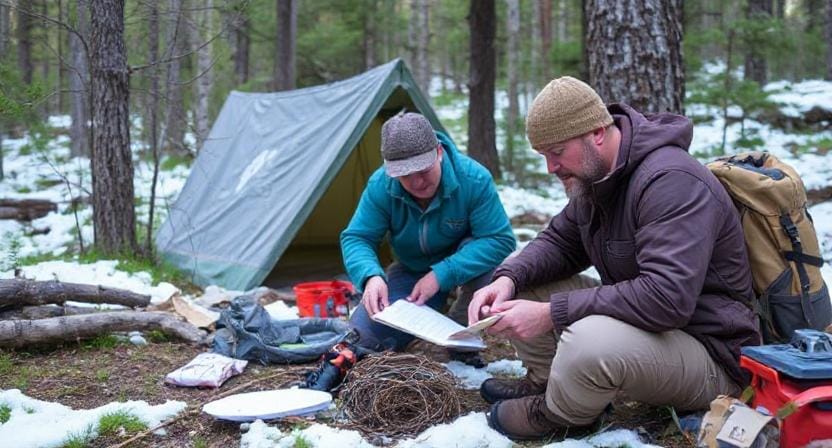Please Note: This post may contain affiliate links. If you click one of them, we may receive a commission at no extra cost to you. As an Amazon Associate, I earn from qualifying purchases.
Last Updated on November 1, 2025 by Kevin Collier

Top Takeaways and Key Concepts
- Use hidden message drops in discreet locations for safe communication with friends.
- Select trustworthy couriers and train them to use secret paths effectively.
- Establish multiple drop points and alternate messengers to ensure system reliability.
- Encrypt messages, avoid personal information, and rotate codes to protect data.
- Plan check-ins and communication routines in advance to stay connected safely.
So, picture this: the world is totally upside down. You’re hiding in your bunker, right? Got your canned beans and, uh, maybe some snacks that make you question your life choices. You’re thinking about your friends just two blocks away. How do you reach them? And more importantly, how do you convince them to share that stash of chocolate?
When things get wild like this, using phones and texts? That’s out the window faster than a squirrel on a sugar rush. But don’t panic! There are cool ways to get messages across, like crafty message drops and courier systems. Super useful stuff.
Message drops are like treasure hunts. You leave a note somewhere safe, maybe under a rock or stuck in a tree. Your friends know the spot. Simple, right? Just don’t hide it too well! You want them to actually find it. Maybe write something fun so they know it’s from you. A little joke, some silly doodle—makes it special.
Let's discuss about delivery mechanisms. You could say it's like having a small post office. You can ask a person you trust to be the “messenger.” They take notes from your house to theirs. If they're lucky, they might even be able to bring back snacks! Just make sure they know how to get there and can keep the task a secret. No one needs more eyes on this chocolate hunt.
It's important to stay in touch during hectic times. It helps you feel less alone. A humorous message or a quick update can make the day better. So, get your supplies together, be creative, and make sure the chocolate comes back to you.
You can do this!
Understanding Message Drops: The Basics

First things first, what is a message drop? Imagine it as a hidden mailbox for the end of the world. It's a safe place to leave notes for other people without having to worry about being seen or heard by unwelcome guests (like those annoying looters).
*** Shop for Survival Gear - Tools - Kits ***
Survival Gear - Bags and Backpacks - Knives - Boots/Footwear - Communication
Outdoor Cooking - Gloves - Hydration - Dry Boxes - Water Filtration Systems
Tents - Sleeping Bags - First Aid Kits - Multi-Tools - Flashlights - Fire Starters
Navigation - Survival Food - Night Vision - Headlamps - Stun Guns - Binoculars
1. Picking the Right Places: It's really important where you put your message drop. You don't want to choose a place that is too conspicuous, such under the “Welcome” mat at your front door. Instead, think about hiding places that aren't as obvious, like beneath an old tree stump or in an empty shed that used to hold someone's collection of lawn gnomes.
2. Marking Your Spot: After you've picked a place to drop off your stuff, make sure it's easy for people you trust to find without drawing notice from other people. A simple rock arrangement or a modest sign may work well here. Just be careful not to make anything that looks like modern art gone bad!
3. Protecting Your Messages: Keep your messages short and to the point. No one wants to have to figure out Shakespeare while trying to stay alive! If you need to, use code language. For instance, instead of saying “I need food,” say “The squirrels are getting hungry.” Believe me, it makes things more fun!
How to Set Up a Courier System

Now that we've figured out our message drops, let's speak about couriers. These are the brave people who are prepared to risk their lives to convey important information (or simply some really fantastic gossip).
1. Choosing Couriers: Pick persons that are trustworthy but yet quiet enough to not draw attention to themselves while on their assignments. Do you remember that one friend who always falls over air? Yeah, maybe don't choose them unless they have some real survival talents hidden somewhere.
2. Train Your Couriers: Just like every strong team requires practice before the big game, so do your couriers! Teach them how to go about through back alleyways and secret paths. This will make them like ninja messengers, but without all the great clothes (though they get extra points if they wear bandanas).
3. Setting Up Signals: Couriers should also use code to talk to each other. For example, they could use hand signals or small movements that don't give away what they want to do if they run into someone suspicious. If you had to explain why you were waving your arms around while carrying a sandwich, it would be really awkward.
Making Backup Plans

Let's face it: things don't always go as planned. Even the best-laid plans can run into problems (or surprise potholes). So it's important to have backup plans.
1. Multiple Drop Points: Instead of just one drop point, think about setting up numerous. This makes your system more reliable. You still have choices if one place is compromised because of nosy neighbors or animals who are too interested.
2. Alternate Messengers: Not everyone will be available all the time, and we hope no one gets stuck in a bad scenario with furious chickens or rogue dogs! Have backup couriers on hand so that communication doesn't completely break down.
3. Set times for check-ins ahead of time: Set up regular check-in times for group members to get updates. Use both messaging tools and direct contact if you can, but be careful not to run into zombies. This way, everyone knows about any changes in the plans or the weather outside.
Keeping Data Safe

When things are crazy, it's really important to keep sensitive information safe, especially when you're telling other survivors about supplies or plans.
1. Encrypting Messages: I'm not a spy like James Bond, but simple encryption methods can stop anybody from figuring out what you're saying! Use strange phrases that only people you trust know what they imply. For example, “The purple penguin swims at midnight” could indicate something completely different than what it says!
2. Don't include personal information: When you leave messages for other people through drops or during courier runs, make sure you don't include any personal information. No one wants their name to be connected back to them if things become rough later on!
3. Change codes often: Last but not least, change codes often! Things that work now might not function tomorrow. Staying ahead of the game keeps our security in place no matter what happens around us.
Stories from Real Life
I can relate to this because I once had a mini-crisis when camping with friends when we realized we had forgotten our map and compass (enter panic mode!). We rapidly made up signals with sticks and yelled exaggerated directions over broad fields. It was like a comedy performance!
We eventually made it home thanks mostly to our hard work and imaginative problem-solving. We learnt a lot about communication systems long before we ever needed them in real-life emergencies!
You know how things can get a little crazy sometimes? Sometimes it's a natural calamity or a family camping vacation that goes completely wrong. When you're on a hiking trail, it's like trying to keep everyone together.
You're out in the woods, when all of a sudden half of your crew is gone. It's time to panic! Your heart is racing like you just saw a bear. But what if you had a plan? What if you could send messages to everyone and keep in touch? That's when message drops and couriers come in. They are like your secret weapons.
Making good message drops is like building a little network. You choose where to stop along the walk or at the campsite. It could be a giant boulder or a tree that looks strange. Put notes there. Just short texts like, “We're at the pond!” Come here to meet us! It's so easy, right? Your relatives can read the notes and know just where to go. It's a fun little treasure hunt that brings everyone together.
Then there is the matter with the courier. Choose someone trustworthy in your group to be your messenger. They can take notes back and forth. They might even be able to bring some additional food! You can send and receive mail while you're outside. Just make sure that everyone knows who the messenger is.
Being ready makes a big difference. It may convert a calamity into simply another day of enjoyment. You may explore, tell stories, and laugh over the campfire instead of worrying about who got lost. It's about keeping everyone safe while producing memories.
Planning beforehand helps you relax. Instead of worrying about keeping track of everyone, you can spend time outside with your family. Those tiny things that link people make experiences even greater.
Frequently Asked Questions
What is a message drop?
A message drop is a hidden location where you secretly leave a note for trusted contacts to retrieve without direct face-to-face communication.
How do I choose a safe drop point?
Select discreet spots that blend naturally into the environment and are easy for your group to identify but difficult for outsiders to notice.
Why use couriers in a collapse scenario?
Couriers allow secure hand-carried communication when electronic systems fail or interception risks are high.
How do I protect information being delivered?
Use code words, avoid names or personal details, encrypt phrasing, and rotate code systems frequently.
Should I rely on only one drop point or courier?
No, multiple couriers and alternate drop sites increase reliability and reduce the risk of total communication failure.
What skills should couriers have?
Couriers should move quietly, understand hidden routes, stay calm under pressure, and follow strict instructions.
How do I keep communication routines consistent?
Plan specific check-in times and locations in advance so all parties know when to confirm message delivery.
Suggested Resources:
Survival Communications During Crisis
https://www.survivalcommunications.com
How To Build a Community Network
https://www.buildcommunitynetwork.com
Emergency Preparedness Guide
https://www.ready.gov/emergency-preparedness-guide

Kevin Collier is a seasoned survivalist and expert in prepping and homesteading, contributing to WiseSurvive.com. With a deep-rooted passion for self-sufficiency and outdoor survival skills, Kevin shares practical advice, strategies, and resources to help individuals prepare for any challenge. His informative articles cover a range of topics, from essential survival techniques to sustainable living practices, empowering readers to thrive in any situation. Whether you're a novice or a seasoned prepper, Kevin's insights will inspire you to take charge of your readiness and build resilience for the future.




